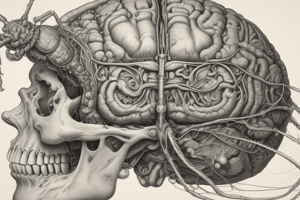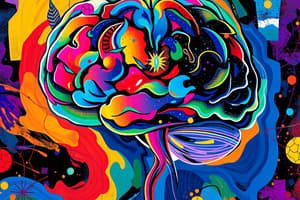Podcast
Questions and Answers
Match the following terms with their definitions:
Match the following terms with their definitions:
Nerves = Stringlike bundles of axons and dendrites CNS = Central Nervous System consisting of brain and spinal cord Neurotransmitters = Chemicals used for communication between neurons Refractory Period = Brief resting pause after a neuron has fired
Match the following phases of action potential with their characteristics:
Match the following phases of action potential with their characteristics:
Resting Potential = Stable potential of approximately -70 mV Depolarization = Membrane potential rapidly shifts to approximately +30 mV Repolarization = Return of membrane potential to its negative resting state Hyperpolarization = Undershoot of resting membrane potential
Match the following ion distributions with their respective locations:
Match the following ion distributions with their respective locations:
Potassium ions (K+) = Higher concentration inside the neuron Sodium ions (Na+) = Higher concentration outside the neuron Calcium ions (Ca2+) = Generally low concentration inside the neuron Chloride ions (Cl-) = Also primarily found outside the neuron
Match the following processes during action potential with their descriptions:
Match the following processes during action potential with their descriptions:
Match the following triggers with their effects on the nervous system:
Match the following triggers with their effects on the nervous system:
Match the following parts of the neuron with their functions:
Match the following parts of the neuron with their functions:
Match the following types of signals in the nervous system with their characteristics:
Match the following types of signals in the nervous system with their characteristics:
Match the following neurotransmitters with their functions:
Match the following neurotransmitters with their functions:
Match the following parts of a neuron with their functions:
Match the following parts of a neuron with their functions:
Match the following types of brain cells with their descriptions:
Match the following types of brain cells with their descriptions:
Match the following brain facts with their details:
Match the following brain facts with their details:
Match the types of cells with their approximate quantities:
Match the types of cells with their approximate quantities:
Match the components of a neuron with their characteristics:
Match the components of a neuron with their characteristics:
Match the following brain development facts:
Match the following brain development facts:
Match the neurotransmitter activity with its location:
Match the neurotransmitter activity with its location:
Match the types of cell communication with the described functions:
Match the types of cell communication with the described functions:
Study Notes
Overview of the Human Brain
- Genes consist of chemical chains that influence the development of the brain and body, with 20,000 to 25,000 identified.
- The mature human brain weighs approximately 1,350 grams and has a pinkish-white color, resembling firm JELL-O.
- Contains about 1 trillion cells and has three major divisions.
Key Cell Types in the Brain
- Glial Cells: Approximately 900 billion; provide structural support, insulation for neurons, and release chemicals that affect neuron growth.
- Neurons: About 100 billion; specialized cells designed for receiving and transmitting electrical signals.
Neuron Structure and Function
- Dendrites: Branched extensions from the cell body that receive signals from other cells.
- Soma (Cell Body): Egg-shaped structure that maintains neuron function and produces necessary chemicals.
- Axon: Long structure that transmits signals away from the cell body.
- Presynaptic Terminals (End Bulbs): Store neurotransmitters for communication with adjacent cells.
- Synapse: Microscopic gap (20-30 billionths of a meter) between neurons where signal transmission occurs.
Nervous System Components
- Peripheral Nervous System (PNS): Comprises nerves outside the brain and spinal cord, composed of bundled axons and dendrites; nerves can regenerate if damaged.
- Central Nervous System (CNS): Composed of neurons located in the brain and spinal cord.
Information Transmission in Neurons
- Resting Potential: Neurons maintain a stable membrane potential of about -70 mV; the inside is negatively charged due to potassium ions and negatively charged proteins.
- Threshold: If membrane potential reaches -55 mV, voltage-gated sodium channels open, initiating an action potential.
- Depolarization: Sodium ions influx leads to rapid membrane potential change, reaching +30 mV.
- Repolarization: Sodium channels close, potassium channels open to restore the negative potential.
- Hyperpolarization: Potassium efflux may overshoot, temporarily decreasing membrane potential below baseline.
- Refractory Period: A brief pause after neuron firing during which new action potentials cannot occur.
Neurotransmitters
- Approximately a dozen different chemicals vital for neuron communication that facilitate mental and physical activities.
Studying That Suits You
Use AI to generate personalized quizzes and flashcards to suit your learning preferences.
Description
This quiz explores the neurobiological basis of psychology, focusing on the human brain, its development, and the role of genes. Discover key facts about the brain's weight, color, consistency, and its complex developmental process. Test your understanding of the intricate connection between biology and psychology.




